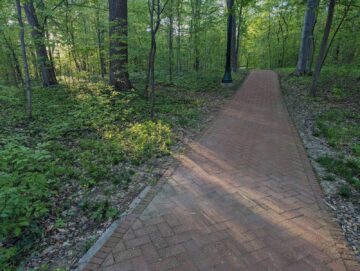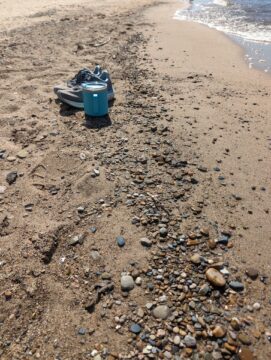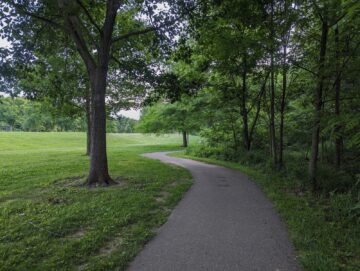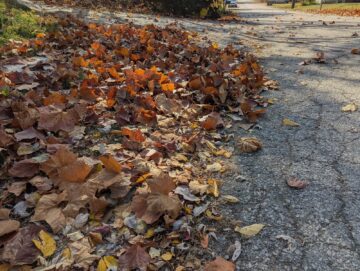by Mary Hrovat
 It sounds like a parlor trick or gimmick, to walk 2,024 miles in 2024—trivial but harmless. It’s not like hiking the Appalachian or Pacific Crest Trail or climbing the highest peak on each continent, or running a marathon. But it is similar to a marathon in that the number involved is an arbitrary product of history that can somehow be useful for guiding a person’s efforts.
It sounds like a parlor trick or gimmick, to walk 2,024 miles in 2024—trivial but harmless. It’s not like hiking the Appalachian or Pacific Crest Trail or climbing the highest peak on each continent, or running a marathon. But it is similar to a marathon in that the number involved is an arbitrary product of history that can somehow be useful for guiding a person’s efforts.
The idea came from a friend. Early in 2020, I mentioned that I’d walked 1,929 miles in 2019, and he suggested that maybe I could walk 2,020 miles in 2020. Adding just under 100 miles, which is less than 2 miles a week, certainly seemed well within my capacity. I sold my car in 2018 and have many reasons to go for a walk. However, I didn’t manage 2,020 miles in 2020, and I couldn’t increase my mileage significantly in subsequent years either, until now. As of this writing (December 14), I’ve walked 2,079 miles. I passed my target a week ago, on a Saturday morning when I walked a couple of loops in my neighborhood to catch some rare December sun and get my day off to a good start.
∞
The years of thinking about my goal but not achieving it had clarified for me the seasonal patterns in my walking: I tend to walk less in summer, when the heat makes it uncomfortable to be outside, and sometimes less in winter if it’s icy or extremely cold. I walk less when I’m held immobile by depression. I usually feel better when I walk, but sometimes I get so far down that it’s hard to leave the house. That’s part of what happened to me in 2020.
In 2020–2023, I noticed that I kept on track toward a number of miles that matched the year fairly well up until about May. After that, I slowly got so far behind that it became impossible to catch up. This year, I thought I’d keep a spreadsheet so that I’d be more aware of how I was doing. I set up one that showed my running total, by week and by month, and how far off I was from my target for each week and month in the year.
 I got off to a very slow start. There was dangerously cold weather in January that kept me indoors, and I fell behind my weekly and cumulative targets almost immediately. I was behind for most of January. Once the weather became walkable again, though, I quickly got ahead of my targets and stayed there until summer. I had so many beautiful winter and spring walks and hikes. The more I walked, the more I wanted to walk.
I got off to a very slow start. There was dangerously cold weather in January that kept me indoors, and I fell behind my weekly and cumulative targets almost immediately. I was behind for most of January. Once the weather became walkable again, though, I quickly got ahead of my targets and stayed there until summer. I had so many beautiful winter and spring walks and hikes. The more I walked, the more I wanted to walk.
In mid-June, I was 132 miles ahead of my target mileage for that time of year. I slowed down again after that, as I thought I might, because of the heat and humidity. In August, a dog bit me and knocked me down, and that put a crimp in my walking for several weeks. I didn’t fall behind my targets again, but at the beginning of September I wasn’t nearly as far ahead as I had been. But then things picked up again. And here I am.
∞
Typically the idea of using a spreadsheet to monitor my life in any way would be unappealing, and it’s hard to describe exactly how I used this particular spreadsheet. The main thing I did was to focus on meeting a daily target of 5.53 miles more often than not and to keep an eye on my weekly target of 38.7 miles. I updated the spreadsheet every week, and I think it helped me to see the numbers, but I don’t know how. There’s a black box between brain and feet sometimes.
I would sometimes go out for a couple of loops around my neighborhood, or pace around my house, or dance, for (almost) no other reason than to reach a target. (I say almost because there’s usually pleasure in walking or dancing. Even on days of low energy or low spirits, there’s some hope that activity will improve matters or at least keep life from becoming too dire.) Overall, however, most of my walking didn’t feel driven by the targets.
 One reason the spreadsheet felt useful was the arbitrariness, even silliness, of the goal. I wasn’t tracking dollars earned or calories eaten. I wasn’t adding up the points I’d earned on assignments and tests in a college course. My goal was deeply unserious. I have reasons for walking (overall health, its effect on my mood, a strong preference for walking over driving or even taking the bus), but I didn’t have a serious reason for walking 2,024 miles this year. The difference between walking 1,929 miles in a year and walking 2,024 miles in a year probably doesn’t have much effect on my well-being, health, or longevity.
One reason the spreadsheet felt useful was the arbitrariness, even silliness, of the goal. I wasn’t tracking dollars earned or calories eaten. I wasn’t adding up the points I’d earned on assignments and tests in a college course. My goal was deeply unserious. I have reasons for walking (overall health, its effect on my mood, a strong preference for walking over driving or even taking the bus), but I didn’t have a serious reason for walking 2,024 miles this year. The difference between walking 1,929 miles in a year and walking 2,024 miles in a year probably doesn’t have much effect on my well-being, health, or longevity.
In other words, the numbers are not the important thing. My energy level, needs, and circumstances (which contribute to my lived experience) are the important things. I might walk to get out of the house, to return or pick up books at the library, to buy groceries, to go see people. I might dance in my living room to express exuberance or release frustration or sorrow. Even if I set out to walk a bit more on a given day primarily because I wanted more miles, I generally kept going until I completed my errands or needed to do something else or decided I was finished moving energetically for a while.
Although the numbers themselves were largely unimportant, the spreadsheet was useful because it showed me patterns. It made it possible to see the year as a series of ups and downs, as a long journey where the overall trend could be good even if progress was irregular. (Life is a baseball season, not the Kentucky Derby.) I know from experience that if I’d thought of my walking goal in terms of unbroken streaks, I’d have gotten discouraged when an inevitable day of little sleep, high pain, or other circumstances caused me to not meet my daily or weekly target. Keeping my eyes on the overall pattern seemed to remove that kind of pressure.
∞
This year not only helped me form a habit of walking slightly more than I used to, but also highlighted the fact that my activity (my life) varies within an overall regularity. Once my body gets used to a certain level of activity, it’s usually easy to keep goin g at a more or less steady pace (barring dog bites and the like), but I sometimes need less active days or weeks. Maybe this is how habits work, or at least how they work for me. They provide a framework that’s loose enough to accommodate day-to-day variation but solid enough to persist through time. Maybe my year has systoles and diastoles of greater and lesser activity, and together they make up a steady-enough heartbeat.
g at a more or less steady pace (barring dog bites and the like), but I sometimes need less active days or weeks. Maybe this is how habits work, or at least how they work for me. They provide a framework that’s loose enough to accommodate day-to-day variation but solid enough to persist through time. Maybe my year has systoles and diastoles of greater and lesser activity, and together they make up a steady-enough heartbeat.
Because my project was essentially goofy, it was fairly easy to look at the spreadsheet as a source of more or less neutral data. In addition, I was already aware organically or intuitively of the patterns to which it gave a more precise shape. Once I got past my slow start and realized that my goal was not probably not going to be difficult to reach, I seemed to be watching patterns emerge rather than actively creating them. It might sound weird, but I suspect we have less control over ourselves than we realize, and the control we do have is more indirect.
After I met my goal last week, I felt mildly curious about how many miles I’ll wind up walking this year. I’d guess the final number will be roughly 2,170 (knock wood), but I don’t know. That number is under my control, but not completely.
The patterns also illustrated the concept of stability within variation in a way that was useful. Even in periods of overall good walking weather, I noticed week-to-week variation in my mileage that was partly due to circumstances but also partly to variations in how active I needed or wanted to be, or could be. Even if I lived someplace that had perfect walking weather year-round, that variation would still exist. I’ve always known, on some level, that my body isn’t a machine and can’t be expected to behave like one, although I’ve often felt ashamed of its departures from that supposed ideal. Over time I’ve come to realize the extent to which our culture pushes us to exhibit, and to expect, machine-like regularity of ourselves. Humans can’t do that well. Some do it less well than others.
 We might like to believe that modern technology puts our hands on all the levers: those of our own lives and futures, the economy, nature. It doesn’t. I found that even a simple thing—walking a set number of miles in a certain time period—wasn’t like steering a car down a well-lit purpose-built road, with complete information at my disposal. I can’t really explain why it worked. It was more like steering the Queen Mary using an imperfect map and systems that I understand only partially, with incomplete awareness of their parameters. I think that’s going to be a good thing to keep in mind.
We might like to believe that modern technology puts our hands on all the levers: those of our own lives and futures, the economy, nature. It doesn’t. I found that even a simple thing—walking a set number of miles in a certain time period—wasn’t like steering a car down a well-lit purpose-built road, with complete information at my disposal. I can’t really explain why it worked. It was more like steering the Queen Mary using an imperfect map and systems that I understand only partially, with incomplete awareness of their parameters. I think that’s going to be a good thing to keep in mind.
∞
You can see more of my work at MaryHrovat.com. The photos are all mine, taken on some of my walks this year. The walks were not all as photogenic as the pictures suggest, but they were all good (except maybe the one where the dog bit me).
Enjoying the content on 3QD? Help keep us going by donating now.
